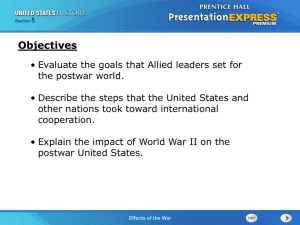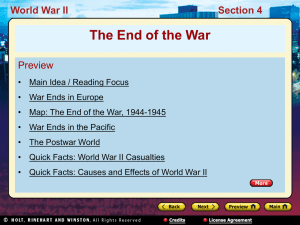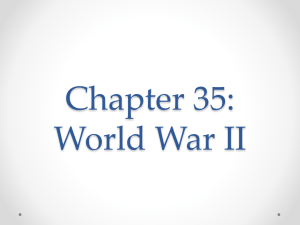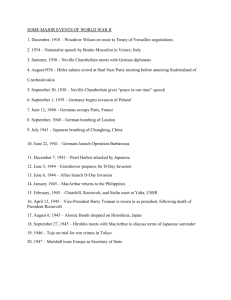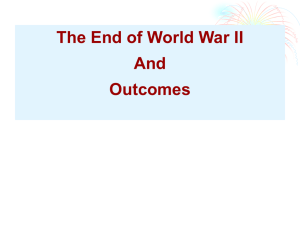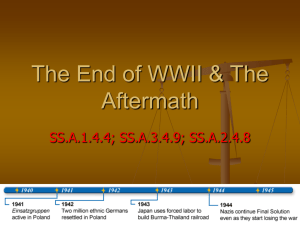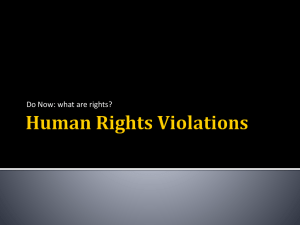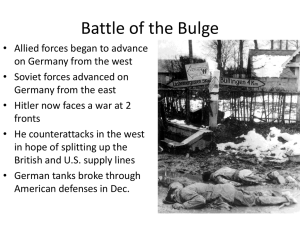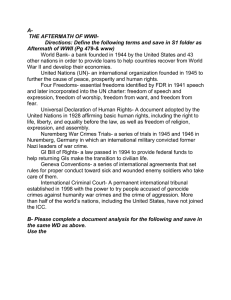D-Day
advertisement
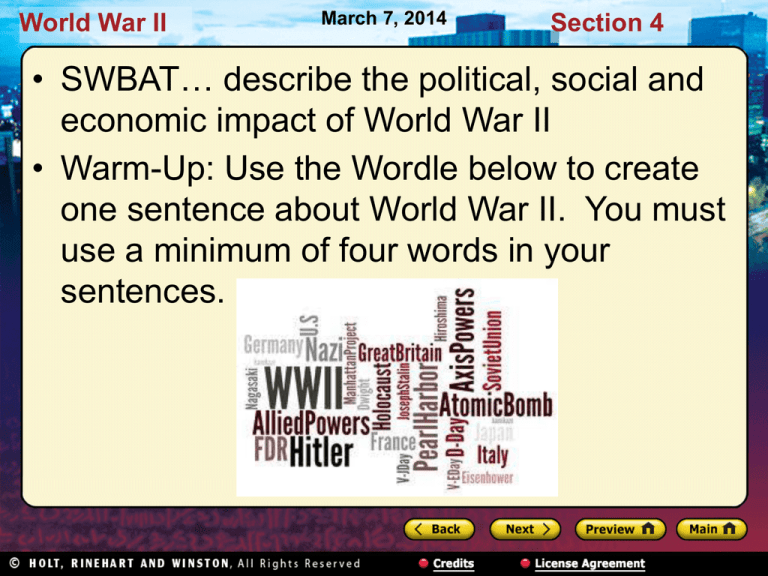
World War II March 7, 2014 Section 4 • SWBAT… describe the political, social and economic impact of World War II • Warm-Up: Use the Wordle below to create one sentence about World War II. You must use a minimum of four words in your sentences. World War II Section 4 • World War II is often considered to be a turning point in history because: • A. the League of nations demonstrated that an international organization could maintain world peace • B. the war brought an end to dictatorships as a form of government • C. European domination of the world began to weaken as nationalism in colonies increased • D. religious and ethnic differences were no longer a source of conflict between nations After World War II, many European colonies sought independence as nationalist feelings swept across these nations. World War II Section 4 The End of the War Main Idea In 1945 the Allies finally triumphed over the Axis powers, but the war left many nations in ruins. Lesson Focus • How did the war end in Europe? • How did the war end in the Pacific? • What were the Allied plans for the postwar world? World War II Section 4 War Ends in Europe • • • • • Soviet advance—pushing Hitler’s troops backward Axis forces with 2 million casualties—outnumbered and outgunned Early 1944, Siege of Leningrad ends; more victories for Soviets followed Axis forces driven back into central Europe Soviets within 40 miles of Berlin by February 1945 D-Day Battle of the Bulge • Second front in Western Europe • Sea assault led by Marshall and Eisenhower • June 6, 1944, invasion at Normandy • Victory came with high casualties • Paris free by end of August • December 1944, one last stand • Counterattack at Belgium • German advance led to bulge in the line • Defeat ended German resistance • Allies racing to Berlin from the east and west World War II Section 4 D-Day • Saving Private Ryan • Lego Version • http://www.youtube.co • http://www.youtube.co m/watch?v=Rj3BKgE6t m/watch?v=GNYKzDo Zs 4w7w World War II Section 4 World War II Section 4 The Germans Surrender • Soviets reached Berlin first • Adolf Hitler found dead in bunker—a suicide • Berlin surrendered May 2, 1945; Germany five days later • Victory in Europe (V-E Day) proclaimed May 8, 1945 • War in Europe finally over after nearly six years World War II V-E Day • http://www.cspan.org/video/?15287 3-1/announcement-veday Section 4 World War II Section 4 Draw Conclusions What effect did D-Day have on the war in Europe? Answer(s): The Allies quickly reconquered much of France and started to push into Germany from the west. World War II Section 4 War Ends in the Pacific Final Battles • By mid-1944, regular bombing raids on Japanese cities, including Tokyo • Great distance made raids difficult, dangerous • Americans needed bases closer to Japan Battle of Iwo Jima • February 1945 island invasion; 750 miles south of Tokyo • 7,000 Americans died in month of fighting; 20,000 Japanese died—only 1,000 thousand surrendered Battle of Okinawa • Only 350 miles from Japan; U.S. troops invaded island April 1945 • By June, 12,000 American soldiers dead • Japanese lost 100,000 defenders and another 100,000 civilians World War II Section 4 The Atomic Bomb • After Okinawa, mainland Japan was next • The U.S. military estimated cost of invading mainland Japan-up to 1 million Allied killed or wounded Option to invasion • Atomic bomb successfully tested in 1945 • Harry S Truman U.S. president with Roosevelt’s death in May 1945 • Forced to make decision—bomb Japanese city to force surrender July 26, 1945 • Allies issued demand for surrender • No response; Hiroshima bombed on August 6 • Still no surrender; second bomb dropped on Nagasaki on August 9 • 145,000 total deaths • Japanese acknowledged defeat Emperor Hirohito surrendered on August 15, 1945. This day is known as V-J Day for Victory in Japan. World War II was finally over. World War II The Atomic Bomb • Dropping the Bomb: Hiroshima • http://www.youtube.co m/watch?v=NF4LQaW JRDg Section 4 World War II Section 4 Find the Main Idea What brought an end to the war in the Pacific? Answer(s): the dropping of atomic bombs on the Japanese cities of Hiroshima and Nagasaki World War II Section 4 The Postwar World • End of war, Europe and Asia in ruins • Tens of millions dead; heaviest losses in Eastern Europe • Germany, Japan, and China had also suffered greatly – Physical devastation; cities, villages, and farms destroyed – National economies near collapse • Millions uprooted – former prisoners of war, survivors of concentration camps, refugees of fighting and of national border changes World War II Section 4 World War II Section 4 Planning for the Future July 1941 • Allied leaders planned for years for the end of war • Churchill and Roosevelt met to discuss even before U.S. entered war Atlantic Charter • Joint declaration of Churchill and Roosevelt • Outlined purpose of war Tehran Conference • December 1943 • Roosevelt, Churchill, and Stalin • Sought no territorial gains • Agreed on schedule for D-Day invasion • All nations could choose their own government • Would work together in peace after the war • Work for mutual prosperity World War II Section 4 Yalta Conference • Held in Soviet territory in early 1945; Allies on brink of military victory • Primary goal to reach agreement on postwar Europe • Roosevelt, Stalin, and Churchill agreed on plans for Germany • Stalin got his way with Polish territory, made promises United Nations • Roosevelt got Stalin to agree to join fight against Japan once war in Europe over • USSR would join new world organization—United Nations • Meant to encourage international cooperation and prevent war • June 1945 charter signed with five major Allies as Security Council World War II Section 4 Potsdam Conference July 1945 Three sides • Small German city location for Potsdam Conference • Soviet Union, Britain, and United States • Growing ill will between Soviet Union and other Allies • Discussed many issues but had difficulty reaching agreement Closing months • American and British leaders worried about Stalin’s intentions • Concerned about spread of communism, growth of Soviet influence Stalin • Soon broke his promises • Did not respect democracies in Eastern Europe • Another struggle beginning World War II Section 4 World War II Section 4 Summarize What major decisions did Allied leaders make at Yalta and Potsdam? Answer(s): At Yalta, Allied leaders agreed on what to do with postwar Europe. Roosevelt persuaded Stalin to join the fight against Japan and to join the United Nations. At Potsdam, the three sides discussed many issues concerning postwar Europe, but often had difficulty reaching agreement. World War II • • • • • • End of World War II Section 4 http://www.youtube.com/watch?v=fJySW_GF_jY Charlie Chaplin http://www.youtube.com/watch?v=QcvjoWOwnn4 Boy in the Striped Pajamas http://www.youtube.com/watch?v=9ypMp0s5Hiw Gas Chamber: http://www.youtube.com/watch?v=REhsVkNyUsE World War II Section 4 • • • • • Which reform took place in Japan after World War II? Japan’s industrial capability was greatly reduced the Emperor’s position was abolished Japan became a representative democracy labor unions were declared illegal • • • • • A major factor in the economic recoveries of Japan and West Germany after World War II was their desire to avoid an invasion from China acceptance into the United Nations ability to produce nuclear weapons need to replace destroyed factories • Which is one major reason the Holocaust is considered a unique event in modern European history? Jews of Europe have seldom been victims of persecution. • Civilians rarely were killed during air raids on Great Britain. • Adolf Hitler concealed his anti-Jewish feelings until after he came to power. • The genocide was planned in great detail and required the cooperation of many people. World War II Section 4 • In groups of 3 or 4, prepare a dramatic scene for a play or film that focuses on an event of effect that might have been suffered by Europeans during World War II. World War II Section 4 Exit Activity • On the front of your post-it, write three effects of World War I. • On the back of your post-it, write a song that represents one of the following events of World War II and explain: – V-E Day – V-J Day – Atomic Bomb – United Nations World War II Section 4 World War II Section 4 World War II Section 4
